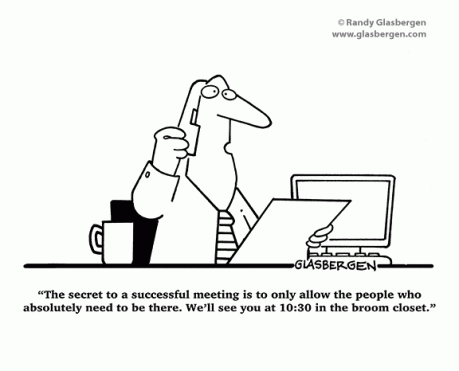Similar to communication, meetings can be considered as a primary process for organizational life. As a result, it is essential to keep meetings effective because they can have significant contribution to the productivity and the success of an organization. In general, meetings can be categorized into 5 types:
- Informational: The main purpose of the meeting is to provide the information to the attendants.
- Problem solving: The attendants work together to find solution for a specific problem.
- Decision making: The attendants discuss together to make a decision on a specific issue.
- Planning: The attendants work together to provide planning for an objective or a project.
- Feedback: The main purpose of the meeting is to react or evaluate an issue or a situation.

From my experience, most of the meetings are not very effective. Here are several popular complains that I usually heard about meetings:
- People come to the meeting without knowing about the purpose of it.
- Irrelevant people are invited to the meeting.
- People do not know what are the expected outputs of the meeting.
- Attendants are not prepared for the meeting.
- Sometimes the meeting ends with no outcome.
- Meeting takes longer than expected.
- There are no follow-up actions after the meeting.

In general, meetings are effective when they:
- Are held only when needed
- Have a specific purpose and expected results
- Are held at an appropriate location and time
- Have the right participants
- Have a clear agenda
- Start on time and end on time
- Stick to the agenda
- Encourage everyone’s participation
- Have balanced and productive discussions
- Have minutes and distribute them
- Have follow-up plan if it is required

In my company, we have adapted some of those ideas to create some kinds of “templates” for effective meetings. There are two templates: one for meeting invitation and one for the structure of the meeting.
The template for meeting invitation suggest that the invitation should have the following information:
- Purpose: Why do we have this meeting?
- Background: Some background information about the topic of the meeting. This can be optional.
- Agenda: Agenda with time frame is strongly encouraged.
- Expected outcomes: Whether it is a document, a plan, a solution or a decision.
- Homework: What attendees should do to prepare for the meeting.
Here is the template for the structure of an effective meeting:
- Purpose, expected outcomes and agenda: Even though these information are available in the meeting invitation, they should be confirmed again by the facilitator at the start of the meeting.
- Follow-up from last time: If this is a follow-up meeting, the facilitator should update the attendants with the progress of follow-up actions since the last meeting before going to the main agenda.
- The main agenda: Now it is time to follow the items in the agenda.
- Conclusion: Sum up and compare the actual outcomes with the expected outcomes.
- Follow-up plan: Decide on what the next actions are or when the next meeting will happen. This can be optional.
- Taking notes: This step happen from the beginning to the end of the meeting. Each meeting must have a note-taker role appointed. Note-taker will send meeting minutes to all stakeholders right after the meeting.